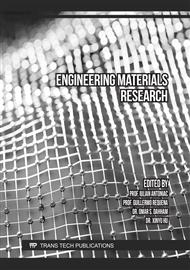[1]
Cheng Y, Zhu J Z, Huang H L. Aerospace gear coating material optimization and coating thickness optimization. Gas turbine testing and research, 2020, 33(01):41-46. DOI: CNKI:SUN:RQWL.0.2020-01-009.
Google Scholar
[2]
Selvarajan. L, Sasikumar. R., Mohan. D. G., et al. Investigations on electrochemical machining (ECM) of Al7075 material using copper electrode for improving geometrical tolerance. Materials Today: Proceedings, 2020, 27(3):27082712.https://doi.org/10.1016/j.matpr. 2019.12.188.
DOI: 10.1016/j.matpr.2019.12.188
Google Scholar
[3]
Yang F, Zhang J, Zhao S, et al. Analysis of flow field for electrochemical machining deep spiral hole with gradually changing groove section. International Journal of Advanced Manufacturing Technology, 2020, 107(10).
DOI: 10.1007/s00170-020-05265-2
Google Scholar
[4]
Jain V. K., PC Pándey. Finite element approach to the two dimensional analysis of electrochemical machining. Precision Engineering, 1980, 2(1): 23-28. https://doi.org/ 10.1016/ 0141-6359(80)90135-X.
DOI: 10.1016/0141-6359(80)90135-x
Google Scholar
[5]
Feng W, Jianshe Z, Yanming L, et al. Experimental research on improving accuracy of electrochemical machining of deep narrow grooves[J]. International Journal of Advanced Manufacturing Technology, 2018.
DOI: 10.1007/s00170-018-1700-z
Google Scholar
[6]
Yao Y H. Study on the Friction Reduction Effect of Laser Electrochemical Composite Micromachining Groove Texture. Wireless Internet Technology, 2020, 17(11): 130-133+138. DOI: CNKI:SUN:WXHK.0.2020-11-059.
Google Scholar
[7]
Farwaha, HS, Deepak D, Brar GS, et al. Design and performance of ultrasonic assisted magnetic abrasive finishing combined with electrolytic process set up for machining and finishing of 316L stainless steel. Materials Today: Proceedings, 2020, 33(3):1626-1631.https://sci-hub.ee/10.1016/j.matpr.2020.06.143.
DOI: 10.1016/j.matpr.2020.06.143
Google Scholar
[8]
Kumar N, Mandal N, Das A K. Micro-machining through electrochemical discharge processes: a review. Materials and Manufacturing Processes, 2020, 35(4):1-42. https://doi.org/10.1080/10426914.2020.1711922.
DOI: 10.1080/10426914.2020.1711922
Google Scholar
[9]
Simsek U, Cogun C, Esen Z. Effects of electrolytic copper and copper alloy electrodes on machining performance in electrical discharge machining (EDM). Machining Science and Technology, 2022, https://doi.org/10.1080/10910344.2022.2044855.
DOI: 10.1080/10910344.2022.2044855
Google Scholar
[10]
Thangamani G, Thangaraj M, Moiduddin K, et al. Performance Analysis of Electrochemical Micro Machining of Titanium (Ti-6Al-4V) Alloy under Different Electrolytes Concentrations. Metals-Open Access Metallurgy Journal, 2021, 11(2):247.
DOI: 10.3390/met11020247
Google Scholar
[11]
Yuanlong Chen, Xiaochao Zhou, Peixuan Chen, et al. Electrochemical machining gap prediction with multi-physics coupling model based on two-phase turbulence flow. Chinese Journal of Aeronautics, 2020, 33(03):1057-1063. https://doi.org/10.1016/j.cja.2019.03.006.
DOI: 10.1016/j.cja.2019.03.006
Google Scholar
[12]
Wang S J, Xiao J, Liu J T, et al. Research on the composite heat treatment process of 20Cr2Ni4A composite heat treatment process for transmission gears. Dongfang Steam Turbine, 2019(02):34-36+41.
Google Scholar



